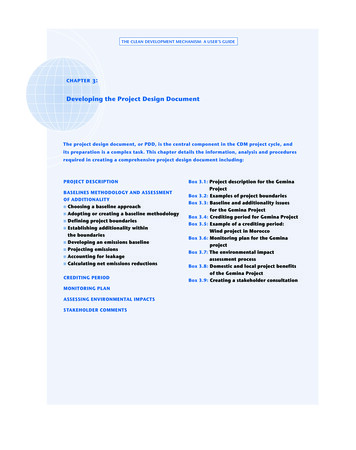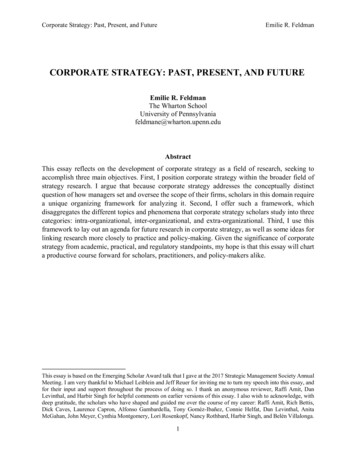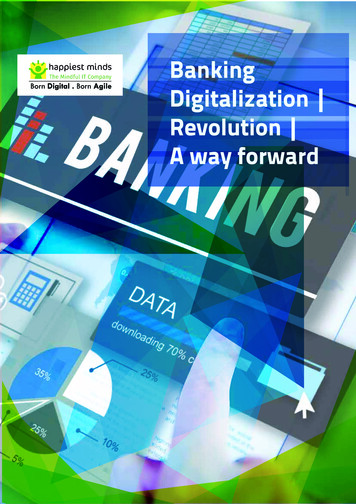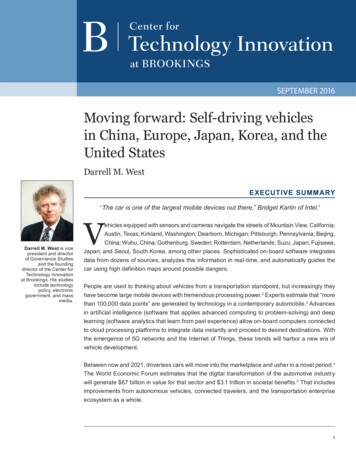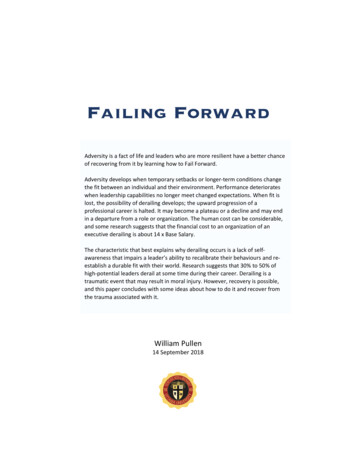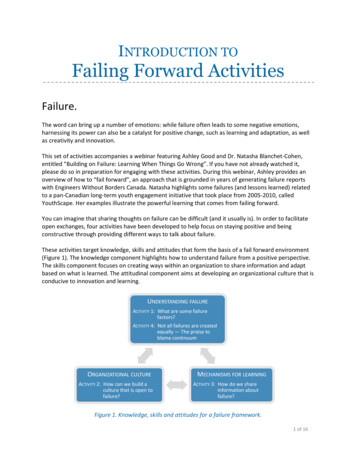
Transcription
Future ForwardUNDP Digital Strategy
Table of ContentsForeword 3Executive Summary 41. Introduction52. Development in a digital world: why transform?62.1 Significant opportunities 62.2 Development challenges and risks 73. UNDP’s Digital Strategy: Pathways to SDGs83.1 The scope of UNDP’s digital transformation83.2 Digital Strategy objectives 83.3 Digital transformation pathway 1 - future state133.4. Digital transformation pathway 2 - future state154. Becoming digital: how will UNDP transform? 174.1 Digital Strategy Activation Plan 184.2 Measuring our progress 205. Glossary21
ForewordYou don’t need to look far or long to see how digital technology istransforming our world. The availability of more and faster internetconnections, satellite data and imagery, plus advances in machine learningand Artificial Intelligence (AI) have made our lives and our economiesunrecognizable from just a generation ago.These technologies and others offer new means of addressing complexglobal challenges, with the potential to unlock longterm and sustainableprosperity for people and planet. However, the very same technologies thatcan bring us together in solving the unparalleled challenges of our timescan also drive us apart, and fuel even greater inequalities both between andwithin countries.As our government counterparts adapt to this rapidly-changing technologicalenvironment, so must UNDP in order to remain a trusted andeffective partner.UNDP’s new Digital Strategy will allow us to better harness technologyand innovation to deliver more and better results in the countries andcommunities where we work. This strategy will also enable us to betterunderstand the potential of digital technologies, articulate their use and value,and readily apply them to better serve our partners in their efforts to achievethe Sustainable Development Goals. Importantly, it will also allow us to betterunderstand the risks and trade-offs that come with these technologies,weighing these factors as we examine and test new technological solutions.As always, UNDP will ensure our efforts in utilizing digital technologies areanchored in the values and obligations defined by the Charter of the UN andthe Universal Declaration of Human Rights.This Digital Strategy is a call to action and innovation, not only for UNDP, butalso for our valued and diverse network of partners. With the launch of theStrategy comes a series of actions to support its implementation. We will: Invest in new learning opportunities to create a commonunderstanding of digital concepts and capabilities across theorganization. Build a global network of Digital Champions who will help identifyneeds and support their colleagues in utilizing digital technologies. Design and implement rapid digital demonstration projects in all areasof our work to demonstrate the potential of these technologies to bothour staff and our partners.Let’s work together to ensure this digital revolution leads to revolutionarysolutions to the complex problems facing this world.Achim SteinerAdministratorUNDP3
ExecutiveSummaryUNDP is committed to the 2030 Agenda forSustainable Development and the principles ofuniversality and equality.We believe in leaving no one behind.UNDP’s vision and ambition, as articulated inits Strategic Plan, 2018-2021 is to be a trustedpartner, nimble in its response, innovative,enterprising and effective as we help countriesachieve the Sustainable Development Goals(SDGs).At UNDP, we developed our Digital Strategythat sets out the vision for the evolution ofthe organisation over the next three years,responding to a changing digital developmentlandscape and the evolving needsof our partners.This strategy is meant to support theachievement of the Strategic Plan by fosteringnew ways of collaborating with our partners,creating environments and systems thatdrive and support innovation, and buildingnew capabilities to develop and apply digitalsolutions that will enhance the quality, efficiencyand effectiveness of our work.Workstream 1: Establish leadership for thedigital transformation“UNDP will continually seek out and embraceexisting and emerging digital technology in allaspects of its work to better serve its partnersin their efforts to achieve the SDGs. Through aprocess of scanning, testing and scaling relevantdigital technologies, UNDP aims to become anincreasingly agile, transparent and effectivepartner in its purpose to eradicate poverty,accelerate structural transformations and buildresilience to shocks and crises everywhere andfor everyone.”The Digital Strategy describes how UNDP willtransform, framed through two inter-relatedtransformation pathways:Digital Transformation Pathway 1 looks outwardat how we can use digital technologies toimprove the way we work, including how wedeliver, create, collaborate and advocate.Digital Transformation Pathway 2 is internallyfocused, and aims to improve the quality,relevance, efficiency, and impact of UNDP sbusiness through better knowledge sharing andimproved data usage.The Digital Strategy also includes an ActivationPlan, consisting of three workstreams, whichoutlines how UNDP will implement the strategyby 2021: Chief Digital-UNDP Officer Digital ChampionsWorkstream 2: Enable Information Technology(IT) to deliver the digital transformation Alignment of IT Strategy and DigitalStrategy Service-oriented IT as a business partnerWorkstream 3: Empower and inspire thebusiness and increase digital capabilities andcapacities Foster innovationDigital literacyDigital communicationAlliances & ecosystemsLighthouse initiativesThe Digital Strategy is not meant to beexhaustive or prescriptive. It outlines thetrajectory to 2021 and proposes a boldtransformation enabled by digital technologiesand new ways of working. UNDP can achievethis by building on our decades of experience,deep country partnerships and the dedicated,professional and innovative people who are ourgreatest asset.4
01IntroductionThere are two important inter-related conceptsthat shape UNDP’s Digital Strategy: “Digitization”and “Digitalization.” Digitization is the process ofconverting physical information into digital formats.It is commonly driven by technologies which focuson enhancing efficiency by automation of existingprocesses. Digitalization is the use of digitaltechnologies to change an organization’s businessmodel, including creating new or improved waysof delivering services, and improving the quality ofwhat is delivered.UNDP’s Digital Strategy is fully supportive of, andaligned with the Strategic Plan 2018-2021 and canbe viewed as an accelerator for the achievement ofit. There are some key issues to note. We have putinclusivity at the core of the Digital Strategy. UNDPwill invest in its staff and provide opportunitiesfor them to learn about the potential that digitaltechnologies offer, while also helping themunderstand how the very same technologies thatcan bring us together in solving problems can alsoworsen inequality.UNDP has experience in both, but not at the scaleof the entire organization, and not in all areas ofour work. The Digital Strategy takes into accountUNDP’s starting point and builds on our experienceand knowledge.We will strive to ensure our digital transformationleads to a more inclusive world.The Digital Strategy focuses on both digitizationand digitalization to shape how we work internally,and with our partners, this includes increasing ourability to leverage existing, emerging and futuredigital technologies in a prioritized and structuredway to improve how we create and deliver value.The Strategy recognizes the wide array of contextsin which UNDP works; digital technologies arenot a panacea and there are contexts and issuesthat will not benefit from the use of them. Knowingwhen to apply technologies and when not towill be a key part of the capabilities that UNDPneeds to build. The Strategy recognises UNDP’sdiverse array of existing digital assets and historyof innovation, but in doing so also notes that theorganization faces certain challenges as it embarkson its digital transformation. For example, UNDP’sdecentralized nature provides conditions fertile forinnovation yet challenging to scale. Until now, ourresponse to specific organizational needs has alsoconstrained our ability to adopt a more strategicperspective in relation to digital.Principles also matter. The Principles for DigitalDevelopment, which include user-friendly designand commitment to open data, open standards,open source development, privacy and securitywill inform our digital transformation. Finally, thestrategy faces the opportunities and challengeswhich arise when your timeline for change isshort—18 to 24 months. Technology moves fast,and UNDP must as well. The document will bereviewed and improved regularly as UNDP buildsits ‘digital DNA’.5
02Development in a Digital World:Why Transform?This chapter introduces the rationale for why UNDP must transform digitally.2.1 Significant opportunitiesDigital technologies are rapidly changing in availability, accessibility, andimpact. Technologies such as Artificial Intelligence, Blockchain, Cryptocurrency,Virtual Reality, the Internet of Things and many more were rarely discussed inthe recent past. Yet, they are now transforming societies, economies, publicand private sector organizations, and individuals across the globe. Sometimesthis is referred to as the “fourth industrial revolution” to demonstrate themagnitude of change.The rapid pace of change and the far-reaching scope of it also means thatdigital technologies emerge and sometimes disappear quickly. This raisesdoubts about the potential of future technological innovations and theirreal impact. Still, most governments are considering digital technologies asa priority and focusing on leveraging their power to address fundamentaldevelopment challenges.From UNDP’s perspective these emerging technologies have the potentialto advance sustainable development and lead to greater developmentimpact; indeed, many technologies are already being used throughout variousprogrammes and initiatives in UNDP at a smaller scale.Our organization has a history of innovation and use of digital technologies;UNDP will continue to pioneer in their use to provide cutting-edgedevelopment solutions, but our ambition has increased, just as the potentialof technology has. As the pace of digital disruption picks up and our partners’demands evolve, it is important that UNDP can leverage existing and emergingtechnologies in a pragmatic and structured manner in order to become a betterpartner for those we serve. Over time, our experience may also be sought byour partners in their own digital transformation efforts.6
02Development in a Digital World: Why Transform?2.2 Development challenges and risksDigital technologies create new challenges. Today, approximately 3.5 billionpeople across the globe are still without access to the internet. Technologiescan contribute to inequality and reduce opportunities. The rapidity of changeand the increasing number of digital technologies available to those whoare connected further heightens the risk of excluding those who are not.Some countries are facing the threat of being left behind, which in turnincreases the risks of widening the digital divide. The UN Secretary Generalhas detailed a Strategy on New Technologies that affirms that the reform ofthe UN and its digital transformation must be anchored in the values andobligations defined by the Charter of the UN and the Universal Declarationof Human Rights. The Secretary General notes that it is vital that weintegrate new technologies in the realization and acceleration of the SDGs,with equality and equity as the guiding principles in this campaign towardsdigitalization and digitization. These issues matter deeply to the UNDP andhave been integrated into this Strategy.7
03UNDP’s Digital Strategy:Pathways to SDGsTwo pathways, one destination. We know where we are. We’re laser-focused onwhere we want to be; using the best of digital to empower those we serve andwork with, and unleashing knowledge within UNDP.3.1 The scope of UNDP’sdigital transformation3.2 Digital Strategy objectivesDigital transformation is comprehensive in nature – it’s not simply an IT issueor one focused solely on operations and administration. For UNDP, our digitaltransformation will use digital technologies to connect knowledge, and makeit more accessible within UNDP and across our networks of partners so asto provide better solutions for those we serve. Our transformation will alsoinclude using digital technologies to create opportunities to develop newbusiness models through innovative financing, partnership, and deliverymodels. Further our digital transformation will include finding more effectiveand efficient ways of operating within the diverse contexts in which UNDPworks. Lastly, we will focus on utilizing digital technologies to communicate,engage and advocate around our purpose, and to build and maintainpartnerships and alliances.The core of the Digital Strategy consists of two inter-related “DigitalTransformation Pathways” that describe the how UNDP will transform itself,and within each of these Pathways is a series of objectives articulating whatwe want to achieve by 2021.8
03UNDP’s Digital Strategy: A hollistic approach to transformationDigital Transformation Pathway 1Pathway 1 focuses on using digital technologies to improve our partner experience and solve development challengesby applying digital technologies and solutions in UNDP’s key activities. Here we aim for innovation in delivery models,co-creation, collaboration, and advocacy journeys.Objective 1.1Objective 1.2Objective 1.3Re/define digitaldelivery modelsEnhance digital co-creation andcollaboration modelsImprove digital partnership,engagement and advocacy journeysUse digital technologies to optimizeand streamline current policy a
3.1 The scope of UNDP’s digital transformation 8 3.2 Digital Strategy objectives 8 3.3 Digital transformation pathway 1 - future state 13 3.4. Digital transformation pathway 2 - future state 15 4. Becoming digital: how will UNDP transform? 17 4.1 Digital Strategy Activation Plan 18 4.2 Measuring our progress 20 5. Glossary 21. 3 You don’t need to look far or long to see how digital .

